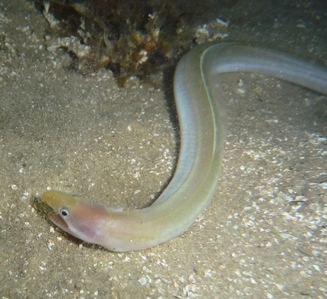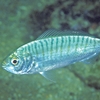Other Names
- Big-eyed worm eel
General Description
Body very long, slender, worm-like, tapering to a point with low dorsal and anal fins barely reaching the sharply pointed tail tip, pectoral fins absent and jaws not extended. Greenish-brown above, pale below. To 60 cm.
Biology
Individuals usually remain buried during the day with only their snout tip visible, hunting for invertebrates at night. They use their bony tail tip to burrow tail first into sediments.
Habitat
Silty and sandy bottoms in bays and along the coast, in depths of 1-150 m.
Soft substrates
Distribution guide
Southern Australia.
Species Group
Depth
Shallow (1-30 m)
Deep ( > 30 m)
Water Column
Max Size
60 cm
Commercial Species
No
Global Dispersal
Native to Australia
Conservation Status
- DSE Advisory List : Not listed
- EPBC Act 1999 : Not listed
- IUCN Red List : Not listed






